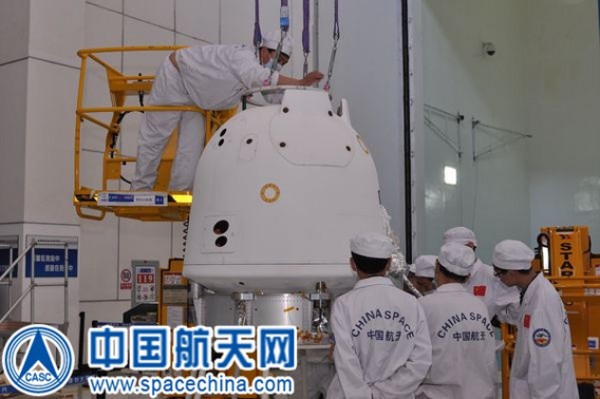All Systems Go For China's Moon Mission
| Dan Weisman | | Oct 16, 2014 09:47 PM EDT |
(Photo : CASC) Final preps took place Thursday for a China moon mission scheduled to launch Oct. 23 from the Xichang Satellite Launch Center.
Final preps took place Thursday for China's moon mission scheduled to launch Oct. 23 from Xichang Satellite Launch Center.
China space scientists planned to send a prototype recoverable lunar probe into lunar orbit and Earth re-entry. The test is designed to validate technology to be used in the Chang'e 5 mission scheduled to collect lunar samples in 2018 and bring them home to Earth.
Like Us on Facebook
Wang Pengji of the China Academy of Space Technology was quoted as saying, "We have begun to study how the Chang'e 5 will blast off from the moon and dock with the in-orbit re-entry capsule."
The specific model being tested next week is an updated version of the Chang'e 3's backup probe. The unmanned Chang'e 3 made history in December 2013 when it became China's first rover and lander to touch down on the moon.
The 14-kilogram (31-pound) moon probe arrived at Xichang in August. It will be launched into lunar orbit before returning to Earth at a speed of more than 40,000 km/h, or about 25,000 miles per hour. The booster will take a European Space Agency payload to the moon before returning to Earth around Halloween.
The Chang'e rover series was named after the Chinese mythological moon goddess. The rover itself was called the Yutu in Chinese, or Jade Rabbit.
Still to go is the tweener in the Chang'e series, the Chang'e 4. That mission will test technologies adapted from Chang'e 3 for the Chang'e 5 slated for a 2018 rendezvous with the Moon. Some reports say the Chang'e 4 may undergo a name change to the Chang 5 T1.
Between then and now, engineers need to fine-tune numerous technologies related to a soft lunar landing and takeoff along with sample collection and storage techniques. Other systems needing to be adapted and tested include docking and high-speed re-entry networks.
side from the European payload that made its way to Xichang two weeks ago, next week's mission has been equipped with numerous scientific instrumentation, including new techniques related to location reporting and an old technology in the form of a radio beacon to aid in message transmission. Additional instrumentation uses new chip technology designed to monitor radiation levels as the probe circles the moon.
Tagsmoon, mission, Space, china's, lunar, NASA, Space, casc, xichang
©2015 Chinatopix All rights reserved. Do not reproduce without permission
EDITOR'S PICKS
-

Did the Trump administration just announce plans for a trade war with ‘hostile’ China and Russia?
-

US Senate passes Taiwan travel bill slammed by China
-

As Yan Sihong’s family grieves, here are other Chinese students who went missing abroad. Some have never been found
-

Beijing blasts Western critics who ‘smear China’ with the term sharp power
-

China Envoy Seeks to Defuse Tensions With U.S. as a Trade War Brews
-

Singapore's Deputy PM Provides Bitcoin Vote of Confidence Amid China's Blanket Bans
-

China warns investors over risks in overseas virtual currency trading
-

Chinese government most trustworthy: survey
-

Kashima Antlers On Course For Back-To-Back Titles
MOST POPULAR
LATEST NEWS
Zhou Yongkang: China's Former Security Chief Sentenced to Life in Prison

China's former Chief of the Ministry of Public Security, Zhou Yongkang, has been given a life sentence after he was found guilty of abusing his office, bribery and deliberately ... Full Article
TRENDING STORY

China Pork Prices Expected to Stabilize As The Supplies Recover

Elephone P9000 Smartphone is now on Sale on Amazon India

There's a Big Chance Cliffhangers Won't Still Be Resolved When Grey's Anatomy Season 13 Returns

Supreme Court Ruled on Samsung vs Apple Dispute for Patent Infringement

Microsoft Surface Pro 5 Rumors and Release Date: What is the Latest?










